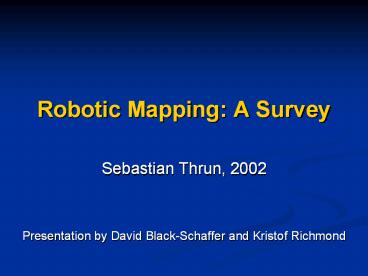Robotic Mapping: A Survey - PowerPoint PPT Presentation
Title:
Robotic Mapping: A Survey
Description:
Robotic Mapping: A Survey. Sebastian Thrun, 2002. Presentation by ... Most current algorithms assume a static environment. Current State of Mapping. Algorithms ... – PowerPoint PPT presentation
Number of Views:173
Avg rating:3.0/5.0
Title: Robotic Mapping: A Survey
1
Robotic Mapping A Survey
- Sebastian Thrun, 2002
- Presentation by David Black-Schaffer and Kristof
Richmond
2
Historical Overview
- Metric Mapping
- Geometric representations
- Occupancy Grids
- Larger maps much more computationally intensive
- Topological Mapping
- Milestones with connections
- Require navigation information
- Hard to scale
3
The Problems
- Measurement noise
- Sensor and Position noise is not independent
- Map size
- High resolution maps can be very large
- Correspondence
- Do multiple measurements at different times
correspond to the same object? - Dynamic environments
- Most current algorithms assume a static
environment
4
Current State of Mapping
- Algorithms
- Robust for static, structured, and limited-size
environments - Probabilistic
- Correspondence Problem
- Incremental vs. Multi-pass
- Unsolved Areas
- Dynamic environments
- Planning exploration paths of unknown environments
5
Why Probabilistic Mapping?
- Noise in commands and sensors
- Commands are not executed exactly (e.g.,
slippage leads to odometry errors) - Sensors noise due to the real-world(e.g., angle
of incidence and scattering) - Noise is not statistically independent
- Control errors accumulate with time/distance
- Can not average out the noise
6
Command Noise
- Odometry Errors heading and distance
measurements accumulate errors with time
7
Sensor Noise
- Sensor probability model depends on the
characteristics of the sensor and the object
being sensed
Basic sonar probability model for angle of
incidence 0. Z-axis P(sd at angle 0) sigma
- std. Deviation for gaussian return from ideal
surface. lambdaF - false positive rate lambdaS -
missed rate d - distance to target on map s -
measured distance from sonar
8
Bayes Rule
- p(xd) ? p(dx) p(x)
- p(xd) is the probability of (the map) x being
true given the (sensor) measurement d - p(dx) is the probability of the (sensor)
measurement being being d given (an object at) x - p(x) is the prior probability (of the map)
9
Bayes Rule in time
- Notation
- s pose of robot (x, y, ?)
- u command given to robot
- z sensor measurment
- m map
- All are functions of time
- zt sensor measurements at time t
- zt all sensor measurements up to time t
- (same for s, u, and m)
10
Bayes Filter
- Assume static world (map m constant)
- p(ztst, m) is the sensor model
- p(stut, st-1) is the motion model
- p(st-1, mzt-1, ut-1) is the probability we were
where we thought we were last time - Generally the sensor model and the motion model
are static
11
SLAM
- SLAM
- Simultaneous Localization And Mapping
- Figure out where we are and what our world looks
like at the same time - Localization
- Where are we?
- Position error accumulates with movement
- Mapping
- What does the environment look like?
- Sensor error (not independent of position error)
12
Monte Carlo Localization
- Probabilistic
- 1. Start with a uniform distribution of possible
poses (x, y, ?) - 2. Compute the probability of each pose given
current sensor data and a map - 3. Normalize probabilities
- Throw out low probability points
- Blur current points (we never know exactly where
we are) - Performance
- Excellent in mapped environments
- Need non-symmetric geometries
13
Monte Carlo Localization
Thrun, Sebastian. Animation of Monte Carlo
Localization using laser range finders
14
SLAM Example
Thrun, Sebastian. Animation of On-line mapping
with Monte Carlo Localization
15
Mapping Methods
Kalman EM Occupancy Grids Dogma
Representation Landmark Locations Point Obstacles Occupancy Grids Occupancy Grids
Incremental YES NO YES NO
Requires Poses NO NO YES YES
Handles Correspondence NO YES YES YES
Dynamic Environments limited NO limited YES
16
Kalman Filter (SLAM)
- Assume Gaussian noise
- Linear motion model
- x(t1) Ax(t) Bu(t) d
- Linear sensor model
- y(t) Cx(t) w
- x includes robot and map states
17
Kalman Filter Performance
- Pros
- Full (Gaussian) posterior probabilities
- Incremental
- Good convergence
- Cons
- Limited model
- Correspondence problem
- Limited map size
- Improvements Lu/Milios
- Improves correspondence
- Non-incremental
18
Newman, Paul. Navigating in a Building Site -
Closed Loop CML
19
Expectation Maximization (EM)
- Find most likely map (and poses)
- Expectation step (E-step)
- Calculate probabilities of robot poses for
current guess of map - Maximization step (M-step)
- Calculate single most likely map for distribution
of robot poses - Iterate
20
EM Performance
- Pros
- Resolves correspondences
- Cons
- Non-incremental
- No posterior probabilities for map
- Slow
- Greedy
- Improvements Hybrid approaches
- Incremental computation
- Maintain a few possible robot poses
21
Occupancy Grids
- Impose grid on space to be mapped
- Find inverse sensor model
- p(mx,yzt,st)
- Update odds that grid cells are occupied
22
Occupancy Grid Example
Moravec, Hans. Robust Navigation by
Probabilistic Volumetric Sensing
23
Occupancy Grid Example
Moravec, Hans. Robust Navigation by
Probabilistic Volumetric Sensing
24
Occupancy Grids
- Pros
- Simple
- Accurate
- Incremental
- Cons
- Require known poses
- Independence assumptions
- Extensions Object Maps
- Reduced memory requirements
- Better for dynamic environments
- Limited by available object models
25
Object Maps
26
Dynamic Environments
- Kalman filters
- Decaying occupancy grids
- Dogma
- Dynamic occupancy grid mapping algorithm































